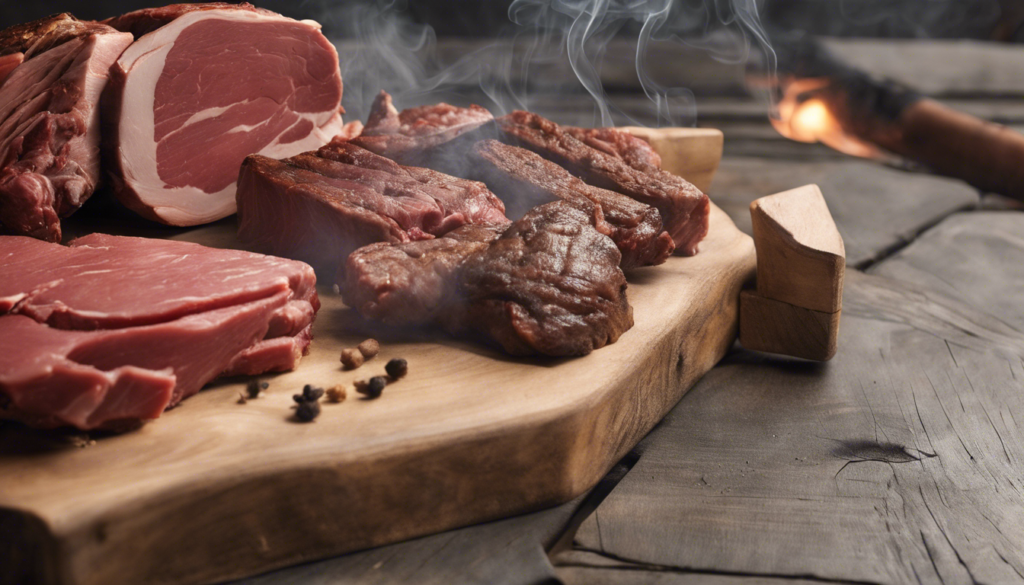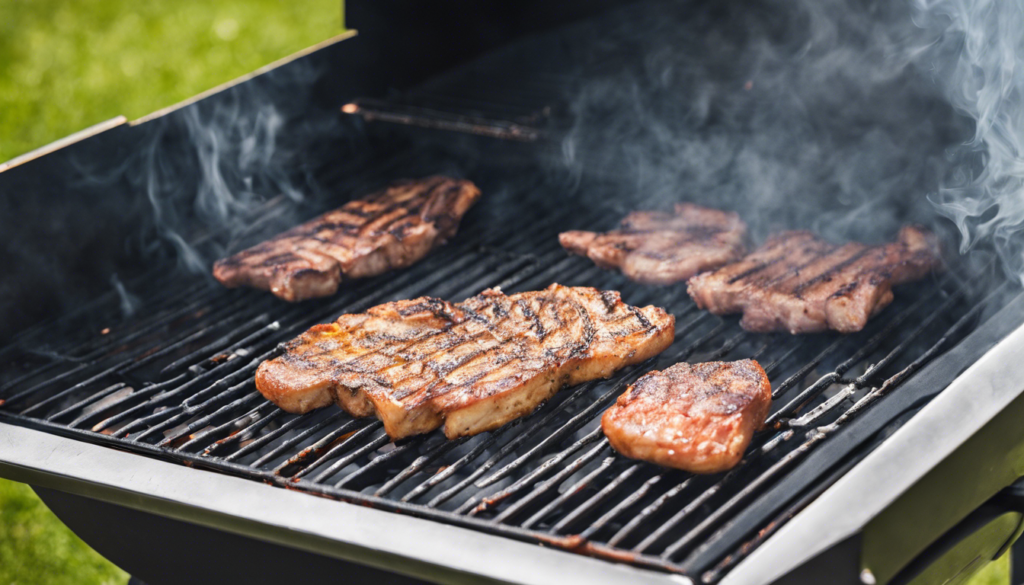Unraveling the Art of Wood Options for Smoking Meat
Picture this: you’re in your backyard, the sun is shining, and you’re preparing to smoke some delicious meat. The aroma of smoke wafts through the air, and you can almost taste the savory, smoky flavor. But wait! What kind of wood are you using? The choice of wood can significantly impact the taste, color, and texture of your smoked meat. It’s not just about throwing any old log on the fire; it’s about understanding the art and science of smoking meat.
Choosing the right wood for smoking meat is akin to selecting the perfect wine to pair with your meal. It can enhance the flavor, add depth and complexity, and transform a good dish into a great one. So, let’s dive into the world of smoking meat and explore the wood options that can take your culinary skills to the next level.
Understanding the Basics of Smoking Meat
Smoking meat is a tradition as old as time. Our ancestors used it as a method of preservation, long before refrigerators were invented. Over time, we’ve come to appreciate the unique flavors that smoking imparts to the meat, turning this ancient preservation technique into a culinary art form.
But what’s the science behind it? The magic begins when the wood is heated. The combustion process breaks down the wood’s compounds, releasing smoke. This smoke contains tiny particles and gases that adhere to the meat’s surface, infusing it with flavor, color, and a tantalizing aroma.
However, not all smoke is created equal. The type of wood, its age, and moisture content can all influence the smoke’s characteristics, making the choice of wood crucial to the outcome.
The Role of Wood in Smoking Meat
Wood plays a starring role in the smoking process. It’s not just about creating smoke; it’s about creating the right kind of smoke. The flavor, color, and texture of your smoked meat are all influenced by the wood you choose.
Each type of wood imparts a unique flavor profile. Some woods produce a mild, sweet smoke, perfect for poultry and fish, while others create a robust, hearty smoke that stands up to the strong flavors of beef and pork. The smoke can also affect the meat’s color, giving it that appealing golden brown hue, and influence the texture by helping to form a desirable crust on the meat’s surface.
So, the next time you’re smoking meat, remember, your wood choice is not just fuel for the fire; it’s a flavor powerhouse that can make or break your dish.
Can You Smoke Meat with Any Wood?
Now, you might be wondering, can I just use any wood for smoking? Well, the answer is a resounding no. Not all woods are suitable for smoking, and using the wrong wood could result in a culinary disaster.
Some woods, like pine and spruce, contain high levels of resin and can produce a bitter, unpleasant smoke. Other woods, such as cedar and cypress, can be toxic when burned and pose a health risk. So, it’s crucial to choose your wood wisely and stick to those known for their excellent smoking properties.
But don’t worry, we’ve got you covered. In the next section, we’ll explore some of the best wood options for smoking meat and help you avoid any smoking faux pas.
Different Types of Wood Options for Smoking Meat
Hardwoods for Smoking Meat
When it comes to smoking meat, hardwoods are the go-to choice. They burn slowly and steadily, producing a consistent smoke that’s perfect for long, slow cooking. Let’s look at some of the best hardwoods for smoking meat:
| Wood Type | Flavor Profile | Best Used For |
|---|---|---|
| Oak | Medium to strong, but not overpowering | Beef, pork, and lamb |
| Hickory | Rich and hearty, slightly sweet | Pork, chicken, and beef |
| Maple | Mildly smoky, slightly sweet | Poultry, cheese, and vegetables |
Fruitwoods for Smoking Meat
Fruitwoods are another excellent choice for smoking meat. They provide a lighter, sweeter smoke that’s perfect for delicate meats like poultry and fish. Here are some top picks:
| Wood Type | Flavor Profile | Best Used For |
|---|---|---|
| Apple | Mild and sweet with a fruity note | Poultry, pork, and fish |
| Cherry | Sweet and fruity, gives a rosy color to the meat | Poultry, pork, and fish |
| Peach | Mild and sweet with a fruity note | Poultry, pork, and fish |
Woods to Avoid When Smoking Meat
While there are many great choices for smoking wood, there are also some you should avoid. As mentioned earlier, some woods can produce unpleasant smoke or even be toxic. Here are a few to steer clear of:
- Pine, fir, and other resinous woods: These can produce a bitter smoke and leave a resinous flavor on the meat.
- Cedar and cypress: These woods can be toxic when burned.
- Wood from trees that produce nuts or berries that are toxic to humans: If the nut or berry is toxic, the wood is likely toxic as well.
When in doubt, stick to the tried-and-true smoking woods like oak, hickory, apple, and cherry. They’re popular for a reason—they produce delicious results!
How to Choose the Right Wood for Your Meat
Choosing the right wood for your meat is like pairing a fine wine with a gourmet meal. The flavors should complement each other and create a harmonious balance. Here are a few tips:
- Match the strength of the wood’s flavor with the strength of the meat’s flavor. Strong-flavored woods like hickory and oak are a good match for strong-flavored meats like beef and pork, while milder woods like apple and cherry go well with milder meats like poultry and fish.
- Consider the cooking time. Hardwoods, which burn slowly and produce a steady smoke, are a good choice for meats that require a long cooking time, while fruitwoods, which burn quicker and produce a lighter smoke, are better for quicker cooking meats.
- Experiment! Don’t be afraid to try different wood and meat combinations. You might discover a new favorite!
Tips for Smoking Meat with Wood
Now that you’ve chosen your wood, it’s time to smoke! Here are a few tips to help you get the most out of your smoking experience:
- Prepare your wood: If you’re using wood chips, soak them in water for about 30 minutes before using to prevent them from burning too quickly. If you’re using logs or chunks, make sure they’re dry and well-seasoned.
- Control the smoke: Too much smoke can make your meat taste bitter. Aim for a thin, steady stream of smoke, not a billowing cloud.
- Control the temperature: Keep a close eye on the temperature and adjust as needed. A good rule of thumb is to keep the temperature between 225 and 250 degrees Fahrenheit for most meats.
Common Mistakes to Avoid When Smoking Meat with Wood
Even seasoned smokers can make mistakes. Here are a few common ones to avoid:
- Over-smoking your meat: More smoke does not mean more flavor. Too much smoke can lead to a bitter taste. Aim for a thin, blue smoke, not a thick, white one.
- Using green or wet wood: Green (unseasoned) wood and wet wood can produce a lot of smoke and create a bitter flavor. Always use dry, seasoned wood.
Mastering the Art of Smoking Meat with Wood
Smoking meat with wood is an art form. It’s about understanding the subtleties of different woods and how they interact with different meats. It’s about patience and precision, taking the time to monitor the smoke and temperature closely. But most of all, it’s about creating delicious, flavorful meat that’s sure to impress.
So, whether you’re a seasoned smoker or a beginner, we encourage you to experiment with different wood options. Try a new type of wood, mix and match woods, or try smoking a different type of meat. The possibilities are endless, and who knows? You might just discover your new favorite combination.
FAQs
What is the best wood for smoking meat?
The best wood for smoking meat depends on the type of meat and your personal flavor preferences. For a strong, hearty smoke flavor, go for hardwoods like oak or hickory. For a lighter, sweeter smoke flavor, fruitwoods like apple or cherry are a great choice.
Can I use any wood for smoking meat?
No, not all woods are suitable for smoking. Some woods, like pine and spruce, can produce unpleasant, bitter smoke. Others, like cedar and cypress, can be toxic when burned. It’s best to stick to woods known for their good smoking properties, like oak, hickory, apple, and cherry.
How do I choose the right wood for my meat?
Match the strength of the wood’s flavor with the strength of the meat’s flavor. Strong-flavored woods like hickory and oak go well with strong-flavored meats like beef and pork, while milder woods like apple and cherry are a good match for milder meats like poultry and fish. Don’t be afraid to experiment with different combinations!


